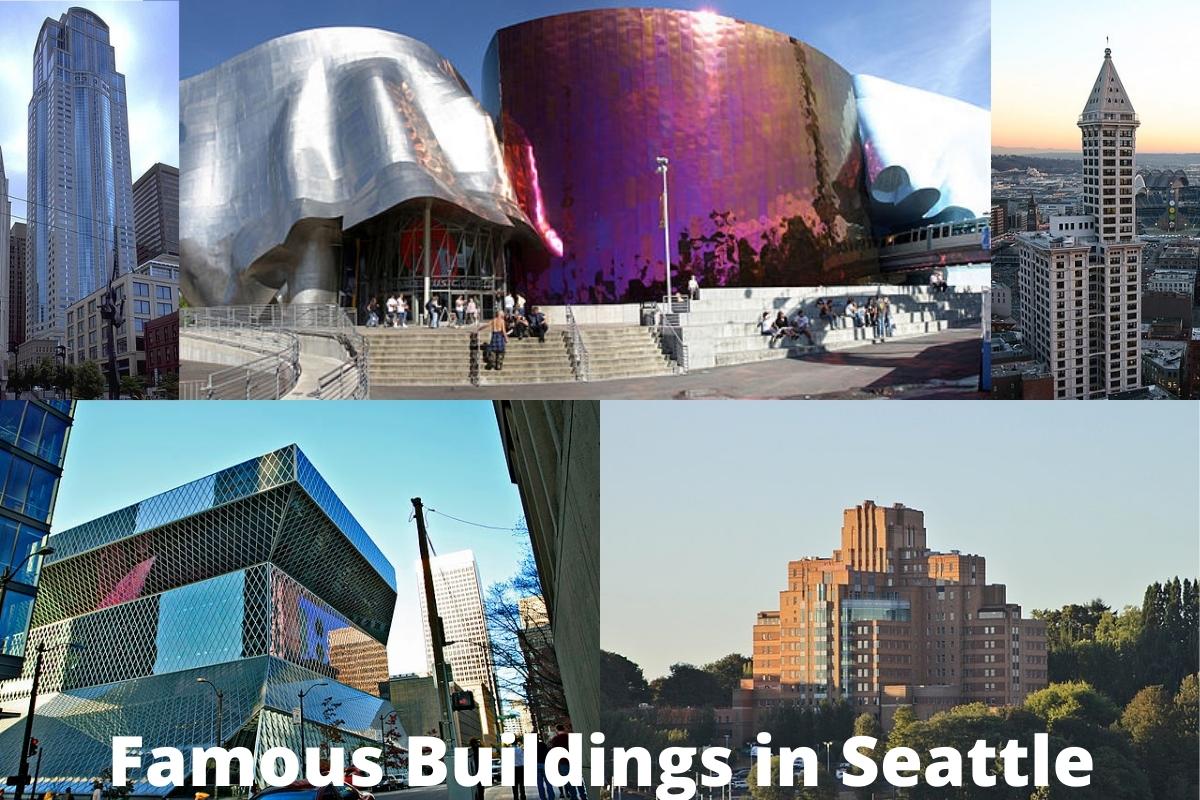Seattle, Washington, is the US Pacific Northwest region’s largest city, and its architecture reflects and has influenced a wide variety of styles.
These date from the time of its founding in the mid-19th century until the present day.
Major development projects have been reshaping the city’s core and surrounding areas since the turn of the 21st century.
Here are some of the most famous buildings in Seattle that you must see when visiting.
Famous Buildings in Seattle
1. Space Needle
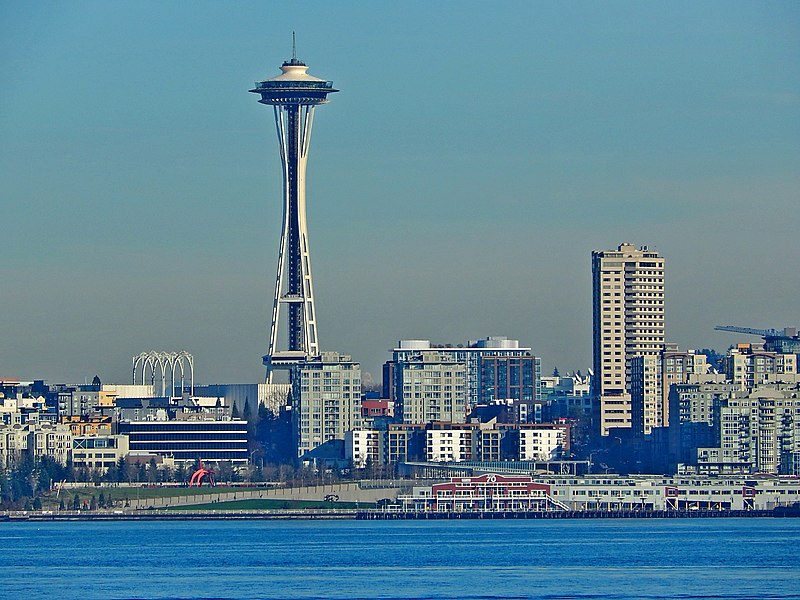
Seattle, Washington, is home to an iconic viewing tower known as “The Space Needle.” Having been recognized as a significant part of Seattle’s history, it was added to the list of official landmarks in 1999.
It sits in the Lower Queen Anne area and in 1962, was constructed in the Seattle Center to host the World’s Fair.
When it was built in 1962, the Space Needle would have been the tallest building on the Mississippi River’s West (184 m).
The tower has a diameter of 138 feet (42 meters), weights 9,550 short tons, plus it’s designed to withstand winds of up to 200 miles per hour (320 kilometers per hour) and earthquakes upwards of 9.0 magnitude, such as the 1700 Cascadia earthquake.
At 520 feet (160 meters) above sea level, its observation deck offers breathtaking views of Seattle and beyond.
The elevator ride takes exactly 41 seconds. There are 848 steps between the basement and the top observation deck on the main stairs.
2. Museum of Pop Culture
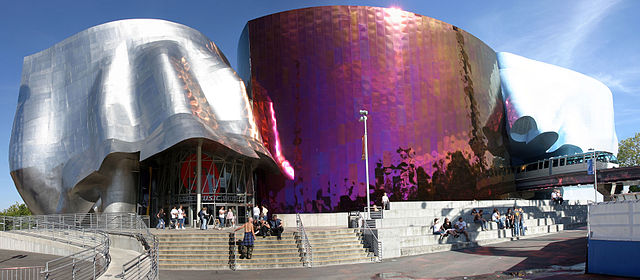
MoPOP, short for Museum of Pop Culture, is devoted to modern forms of popular entertainment. Paul Allen, a Microsoft co-founder, started it in 2000 as the Experience Music Project.
You’ll find the Museum on the grounds of Seattle Center, close to the Monorail and Space Needle. That’s one reason that Forbes ranked it among the 10 ugliest structures in the world.
The building has been criticized by some, but it has also been termed an appropriate setting for the vastest Jimi Hendrix artifacts collection globally.
The building’s facade is a kaleidoscope of hues and patterns, with shimmering purple haze and metallic blue, red, silver, and gold.
3. Seattle Central Library
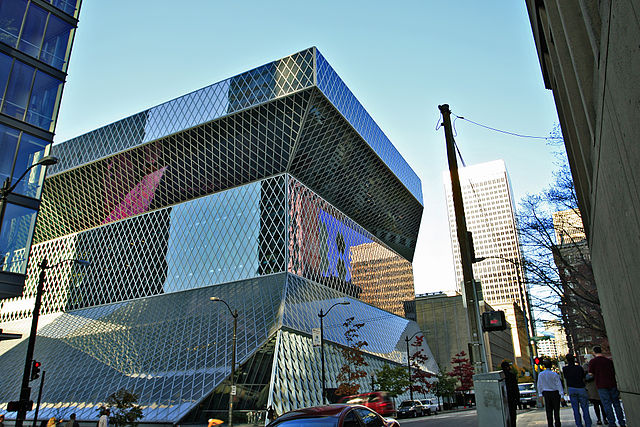
The city’s Public Library system is anchored by the Seattle Central Library, its crown jewel.
In spring 2004, the public got access to the 11-story (185-foot-tall) glass and steel structure in Seattle. Joshua Prince-Ramus and Rem Koolhaas of OMA/LMN were the lead architects.
The 362,987ft² public library has the potential to contain around one and a half million books and other items. It includes public parking underground for 143 automobiles and approximately 400 computers accessible to the public.
A total of almost two million people used the library in its first year of operation. It’s the third time that the city has established a library at the same location.
The library has unique, stunning aesthetics, including multiple discrete “floating platforms” plainly encased in a vast steel net surrounding glass skin. In June of 2004, the building’s architecture was the subject of guided tours.
The American Institute of Architects ranked it as the 108th best building in the United States out of the top 150 that year.
4. Smith Tower
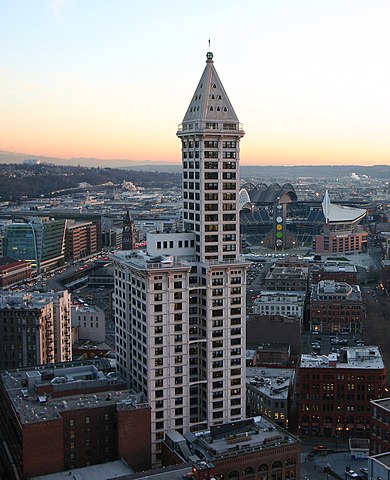
Located in Seattle, Washington’s Pioneer Square, the Smith Tower is a soaring office building. The 38-story, 484-foot-tall (148-meter-tall) tower was completed in 1914 and is the city’s oldest skyscraper. It was also one of the tallest buildings outside of New York City at the time.
To the Mississippi’s west, it had been the tallest structure, but the erection of the Kansas City Power & Light Building in 1931 ended its stint.
Even though the tower is named for typewriter and firearms tycoon Lyman Cornelius Smith, his son Burns Lyman Smith was mostly responsible for its construction following the elder Smith’s death in 1910.
Before 1929, it was called the L.C. Smith Building, but in that year, it was officially renamed the Smith Tower. It was recognized as a Seattle landmark in 1984.
5. Rainier Tower
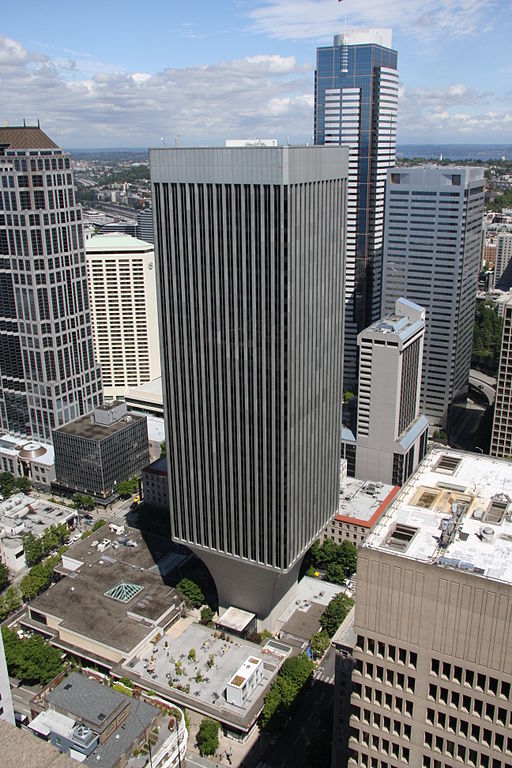
One of Seattle’s tallest buildings, Rainier Tower, is located at 1301 Fifth Avenue in the city’s Central Business District. It was designed by renowned architect, Minoru Yamasaki, and construction ended in 1977.
The 11-story skyscraper is perched above a tapering 37 m (121 ft) concrete pedestal base, giving it the appearance of an inverted pyramid from higher vantage points.
Yamasaki, the architect, opted for the plan to keep Seattle’s downtown green while making room for a larger shopping mall.
The University of Washington owns One Union Square, which is connected to the underground shopping mall, Rainier Square (UW).
In 2017, they tore down that mall. Since the structure resembles a tree that has been cut down by a beaver, locals commonly refer to it by that name. Formerly, it was known as the “golf tee” structure.
6. Columbia Center
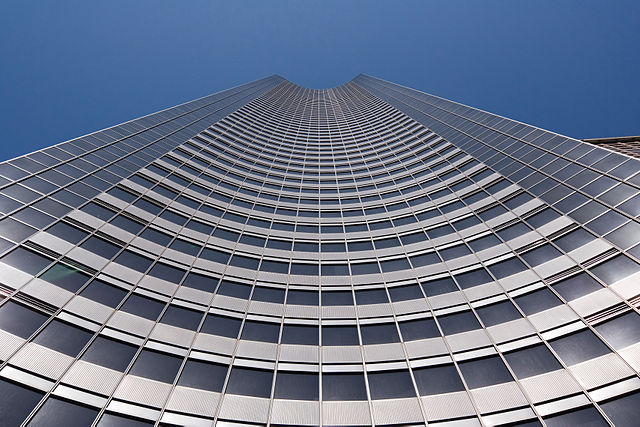
Located in the heart of Seattle, Washington, United States, the Columbia Center was formerly known as the Bank of America Tower and the Columbia Seafirst Center. At 933 feet in height, this 76-story skyscraper dominates Seattle and all of Washington (284 m).
Before the erection of the Transamerica Pyramid in Los Angeles and the Salesforce Tower in San Francisco, the Columbia Center was the tallest skyscraper on the West Coast.
Martin Selig commissioned Chester L. Lindsey Architects to build the Columbia Center in 1982, and construction lasted until 1985. There are predominantly class-A office spaces leased by a variety of businesses in the building, with retail on the ground floor and an observatory as well as a private club lounge on the top floors.
The observation deck atop the tower is the best in the western half of the United States. It takes up the majority of the block encompassed by Fourth and Fifth Avenues, as well as Cherry and Columbia Streets.
7. King Street Station
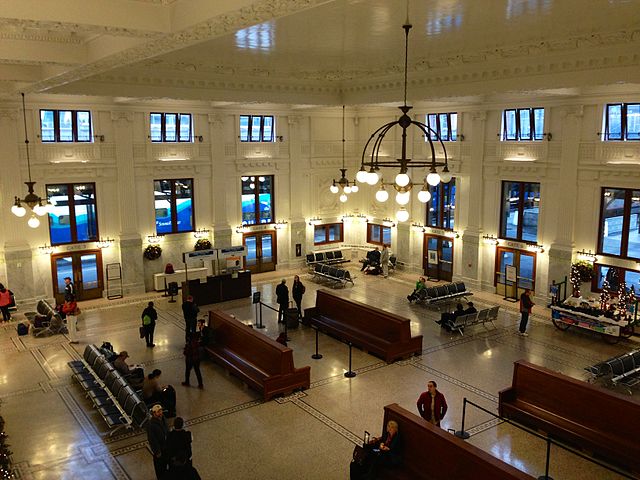
Seattle Streetcar service and Link light rail at International District or Chinatown station both originate from King Street Station. The Northern Pacific Railway and the Great Northern Railway, controlled by James J. Hill, shared this station upon its opening on May 10, 1906.
Reed and Stem, the architects responsible for the station’s design, drew inspiration from several different architectural styles when creating it, most notably the Campanile of St. Mark in Venice for the building’s distinctive clock tower.
The King Street Station was frequently refurbished throughout the 20th century as passenger train services dwindled and the station fell into disrepair.
This building, located in Seattle, Washington, was chosen as the lone Amtrak station in 1971 and added to the National Register of Historic Places in 1973.
In 2008, the city of Seattle purchased King Street Station, and in 2013, after spending $55 million renovating it, it reopened with its original fixtures intact.
8. Pacific Tower
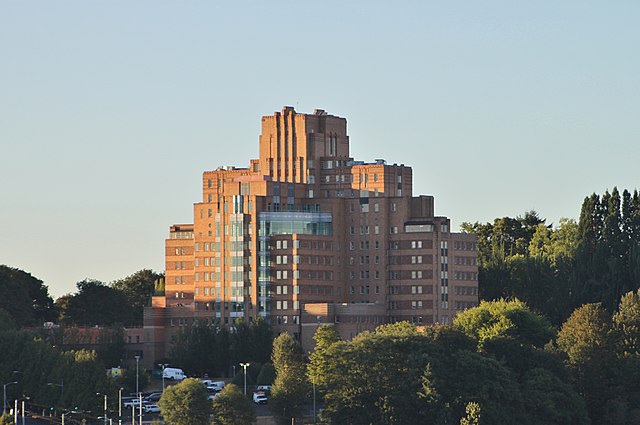
Located on Seattle’s Beacon Hill, the Pacific Tower (formerly known as the Pacific Medical Center) stands 16-stories high.
When construction was finally finished in 1932, it was unveiled the following year as a PHS clinic in the United States. Down to the basement, it serves as a medical center even now.
With input from John Graham & Company, Carl Frelinghuysen Gould of Bebb and Gould conceived and oversaw the construction of this building in the distinctive Art Deco style. The building dominates the skyline and draws attention from far and wide.
Seattle has designated it a landmark, and it is included on the National Register of Historic Places. In the 1990s, the building was strengthened to better withstand an earthquake, but the 2001 Nisqually earthquake caused substantial damage to several areas.
9. Ward House
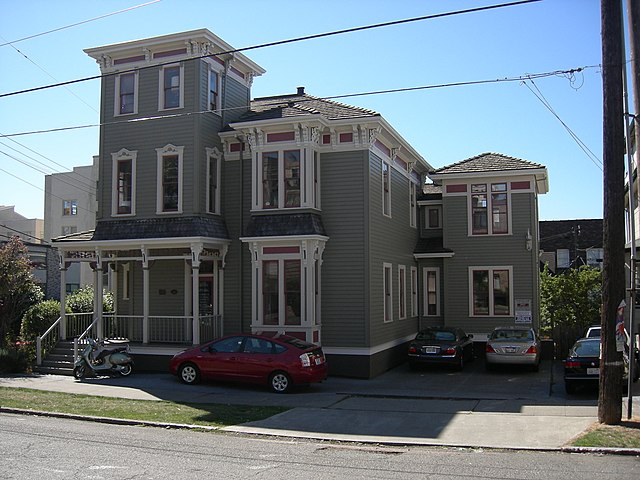
The Ward House is a residence in Seattle, Washington, USA, located atop Capitol Hill. It is among Seattle’s oldest residences, having been constructed in 1882.
The building at 1427 Boren Avenue was designed, constructed, and first owned by George W. Ward. Victor Steinbrueck, an architect, described it in print in 1962.
Nevertheless, it stopped being occupied in 1974, and demolition was planned for the mid-1980s. Dr. and Mrs. Michael Buckley gave the building to Historic Seattle, a public development authority with a focus on architectural preservation.
Historic Seattle subsequently sold it to David Leen. Up until 2016, the building housed Leen’s law office along with several other solo practices.
New owners and tenants Tola Capital, LLC have updated the building’s interior fixtures and furnishings and opted to repaint the building’s exterior, provoking mixed reactions from the neighborhood.
The structure has received both the National Register of Historic Places and City of Seattle Landmark designations.
10. 1201 Third Avenue
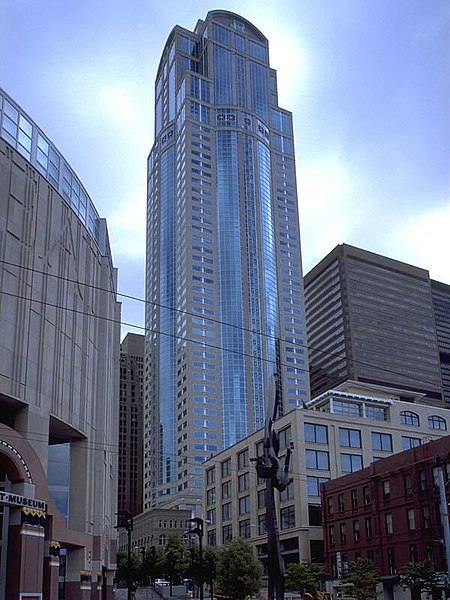
The Washington Mutual Tower, now known as 1201 Third Avenue, is a 55-story (772 ft) skyscraper in Seattle’s central business district.
It ranks as the third highest structure in the metropolitan area, the eighth tallest on the Pacific Coast, and the 97th tallest in the entire country.
Wright Runstad & Company oversaw the entire development process from 1986 through 1988. The architects responsible for the layout of 1201 Third Avenue are Kohn Pedersen Fox Associates and The McKinley Architects.
Washington Mutual’s global offices were located here from the building’s inception in 1972 until 2006 when the company relocated to the WaMu Center across the street (renamed the Russell Investments Center after the bank collapsed in 2008).
In 2012, the skyscraper was purchased for $548.8 million by MetLife Real Estate Investments and Clarion Partners.

